
A cappuccino is an espresso-based coffee drink that is traditionally prepared with steamed milk including a layer of milk foam.
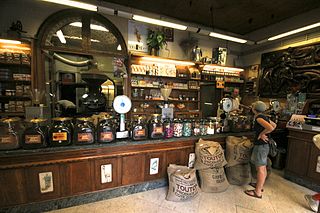
Italians are well known for their special attention to the preparation, the selection of the blends, and the use of accessories when creating many types of coffees. Many of the types of coffee preparation known today also have their roots here. The main coffee port in Italy is Trieste where there is also a lot of coffee processing industry. Italian coffee consumption, often espresso, is highest in the city of Trieste, with an average of 1500 cups of coffee per person per year. That is about twice as much as is usually drunk in Italy.

Caffè latte, often shortened to just latte in English, is a coffee drink of Italian origin made with espresso and steamed milk, traditionally served in a glass. Variants include the chocolate-flavored mocha or replacing the coffee with another beverage base such as masala chai, mate, matcha, turmeric or rooibos; alternatives to milk, such as soy milk, almond milk or oat milk, are also used.
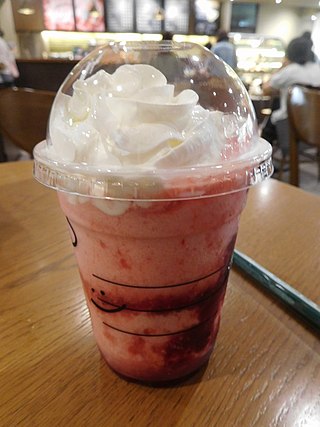
Frappuccino is a line of blended iced coffee drinks sold by Starbucks. It may consist of coffee or crème base, blended with ice and ingredients such as flavored syrups and usually topped with whipped cream and or spices. It may also include blended Starbucks refreshers. Frappuccinos are also sold as bottled coffee beverages in grocery stores, convenience stores and from vending machines.

Café au lait is coffee with hot milk added. It differs from white coffee, which is coffee with cold milk or other whiteners added.
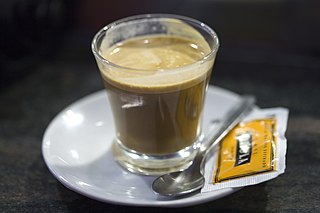
A cortado is a Spanish beverage consisting of espresso mixed with a roughly equal amount of warm milk to reduce the acidity, although the exact ratios have considerable regional variation. The milk in a cortado is steamed, but not frothy and "texturized" as in many Italian coffee drinks. The cortado is commonly served all over Spain. The word cortado is the past participle of the Spanish verb cortar, in the sense of "dilute", and can refer variously to either coffee or espresso drinks throughout Spanish and Portuguese speaking countries.

A caffè mocha, also called mocaccino, is a chocolate-flavoured warm beverage that is a variant of a caffè latte, commonly served in a glass rather than a mug. Other commonly used spellings are mochaccino and also mochachino. The name is derived from the city of Mokha, Yemen, which was one of the centres of early coffee trade. Like latte, the name is commonly shortened to just mocha.

Teh tarik is a popular hot milk tea beverage most commonly found in restaurants, outdoor stalls, mamaks and kopitiams within the Southeast Asian countries of Malaysia, Indonesia, Singapore, and Thailand. Its name is derived from the process of repeatedly pouring the drink back and forth from one container into another with arms extended during preparation, which helps to slightly cool the tea for consumption and giving it a frothy head. It is made from a strong brew of black tea blended with condensed milk. It is the national drink of Malaysia.

Vietnamese iced coffee is a traditional Vietnamese coffee recipe. It is created using coffee roasted between medium and dark. The drink is made by passing hot water through the grounds into a cup that already contains condensed milk. To serve the drink cold, ice is added to the cup.

Café Cubano is a type of espresso that originated in Cuba. Specifically, it refers to an espresso shot which is sweetened. However, the name is sometimes used to refer to coffee based drinks that include Cuban espresso as the main ingredient, such as café con leche.
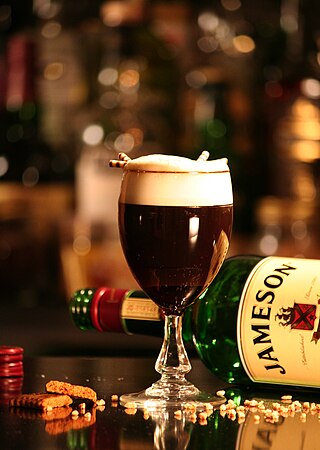
A liqueur coffee is a caffeinated alcoholic drink that consists of a shot of liqueur, mixed with coffee. It is typically served in a liqueur glass, often accompanied with cream and sugar. Coffee liqueur beverages are served in different fashions and can be found throughout many countries. One of the most popular liqueur coffee beverage is commonly known as Irish coffee. Liqueur coffee beverages are largely classified as cocktails as well as digestifs which are aimed at aiding the digestive process typically after a meal.

Café con leche is a coffee beverage common throughout Spain and Latin America consisting of strong coffee mixed with scalded milk in approximately equal amounts. The amount of milk can be higher in a café con leche en vaso or a café con leche de desayuno. Cuban and Puerto Rican establishments often prepare the drink with sugar. Sugar or sweetener is added to taste. It is similar to the Italian caffè latte and the French café au lait.
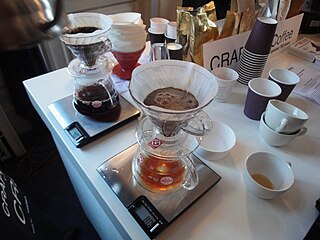
Coffee preparation is the process of turning coffee beans into liquid coffee. While the particular steps vary with the type of coffee and with the raw materials, the process includes four basic steps: raw coffee beans must be roasted, the roasted coffee beans must then be ground, and the ground coffee must then be mixed with hot or cold water for a specific time (brewed), the liquid coffee extraction must be separated from the used grounds, and finally, if desired, the extracted coffee is combined with other elements of the desired beverage, such as sweeteners, dairy products, dairy alternatives, or toppings.

Milk coffee is a category of coffee-based drinks made with milk. Johan Nieuhof, the Dutch ambassador to China, is credited as the first person to drink coffee with milk when he experimented with it around 1660.

An affogato, more traditionally known as "affogato al caffè", is an Italian coffee-based dessert. It usually takes the form of a scoop of plain milk-flavored or vanilla gelato or ice cream topped or "drowned" with a shot of hot espresso. Some variations also include a shot of amaretto, Bicerin, Kahlúa, or other liqueur.
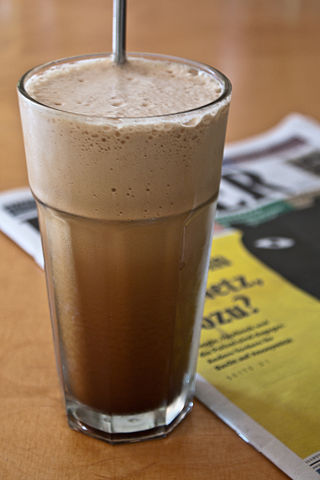
A frappé coffee, cold coffee, Greek frappé, or just frappé is a Greek iced coffee drink generally made from spray-dried instant coffee, water, sugar, and milk. The word is often written frappe. The frappé was invented in 1957 in Thessaloniki through experimentation by Dimitris Vakondios, a Nescafe representative. Frappés are among the most popular forms of coffee in Greece and Cyprus and have become a hallmark of postwar outdoor Greek coffee culture.
Caffè crema refers to two different coffee drinks:

Mazagran is a cold, sweetened coffee drink that originated in Algeria. Portuguese versions may use espresso, lemon, mint and rum, and Austrian versions are served with an ice cube and include rum. Sometimes a fast version is achieved by pouring a previously sweetened espresso in a cup with ice cubes and a slice of lemon. Mazagran has been described as "the original iced coffee".
Countries have cultivated coffee beans into various vehicles to satisfy needs unique to each country. Whether it be for energy, socialization, or tradition, the cultivation of coffee has served as a motivating force of the world. The modernization of coffee and its unique forms across cultures are markers of tradition and modern changes across continents. Coffee culture appears in the way in which people consume coffee, the way they make it, and where coffee is served and shared. Each of these factors combined reflects the lives of the people in these countries and the importance of coffee across the world.





















